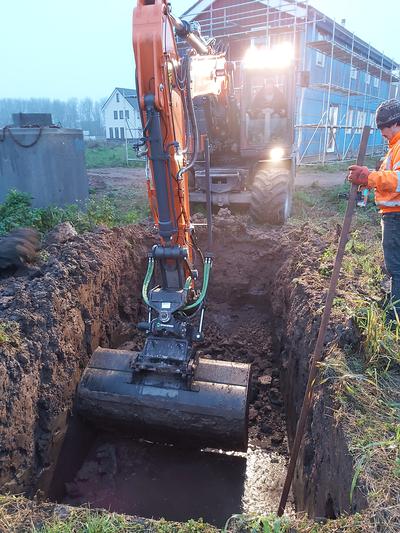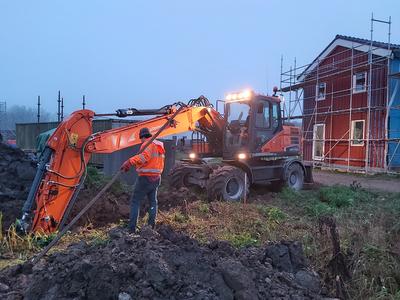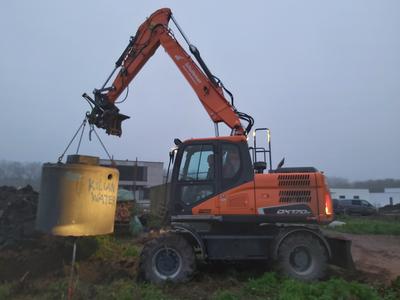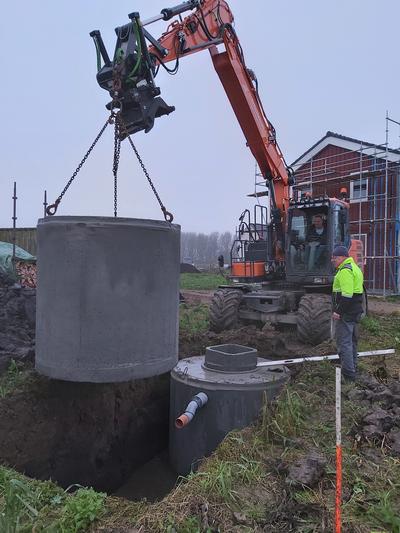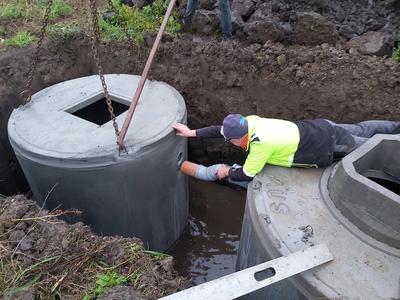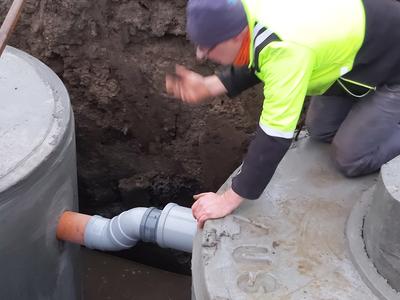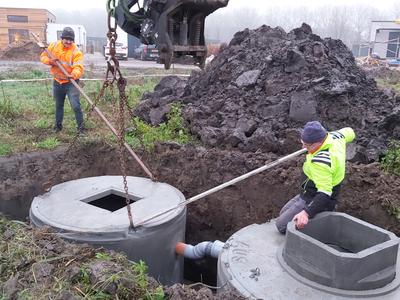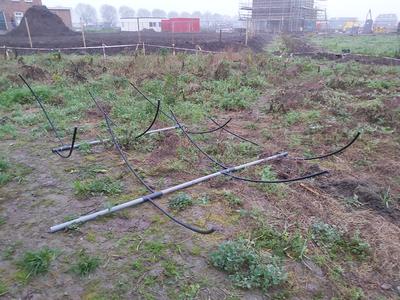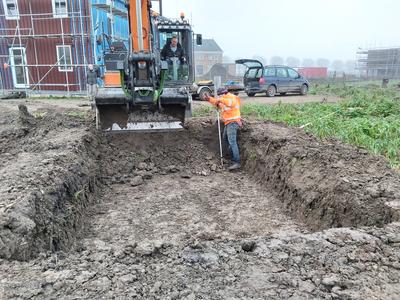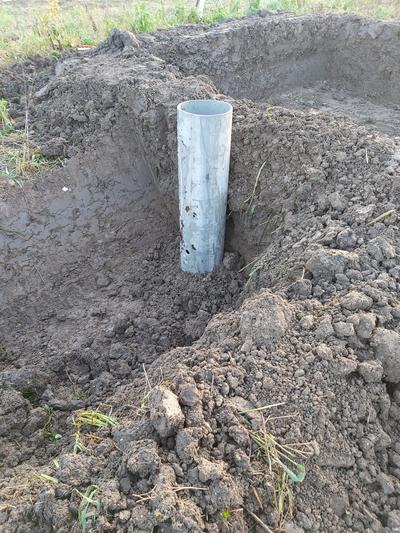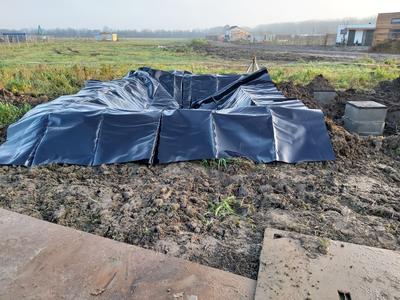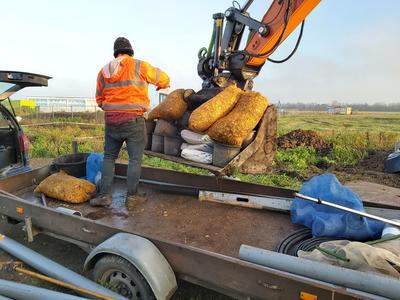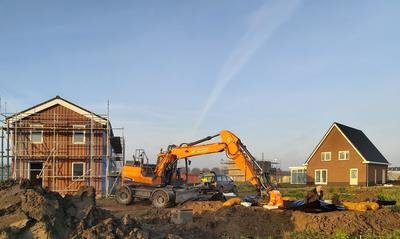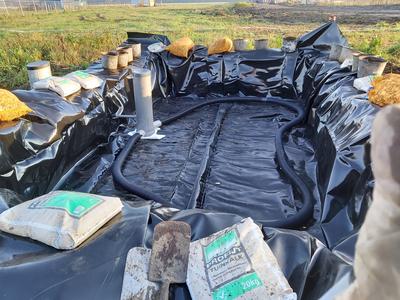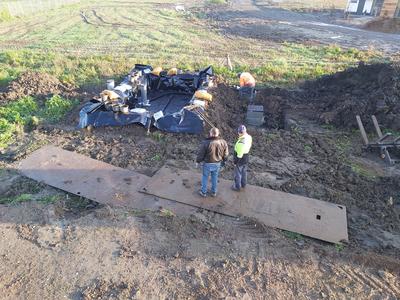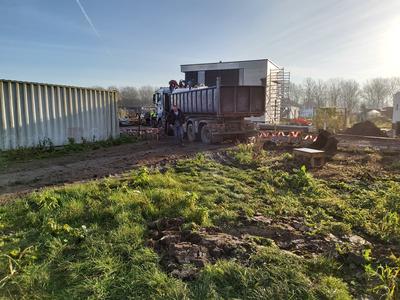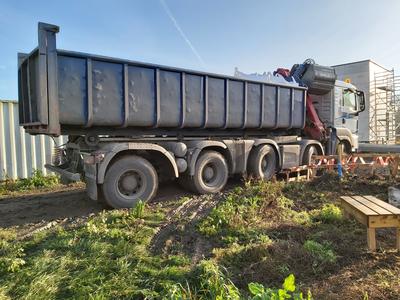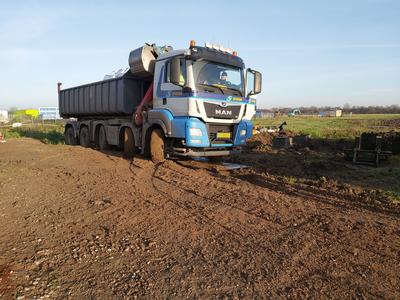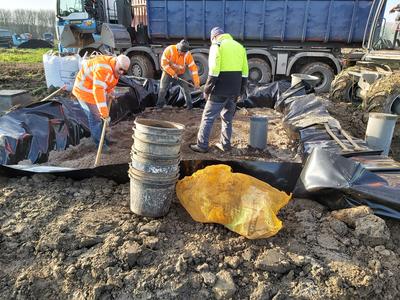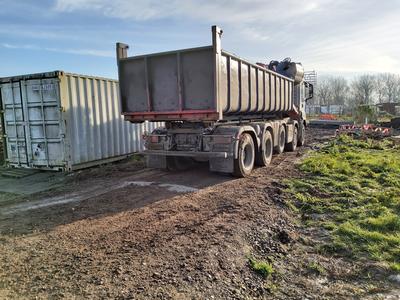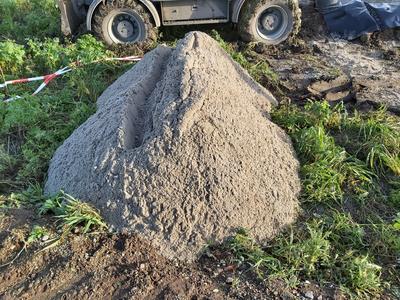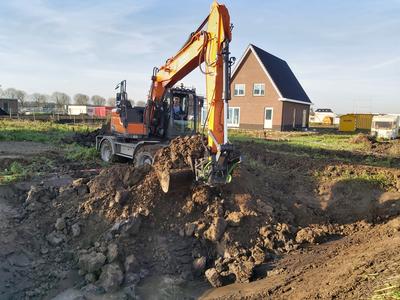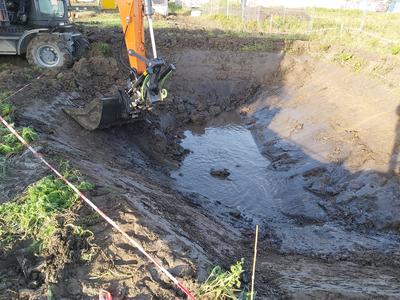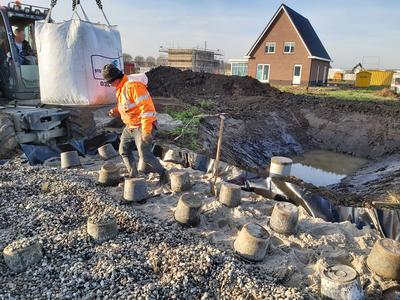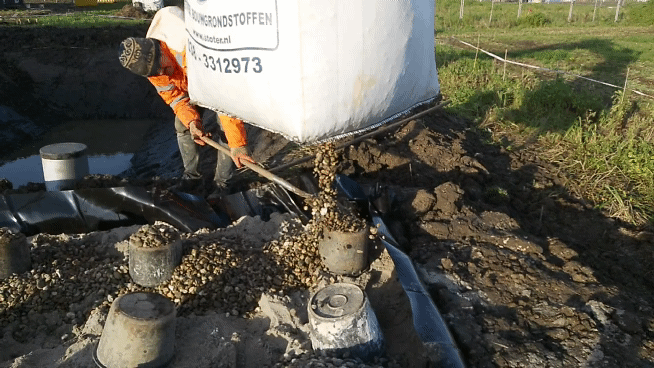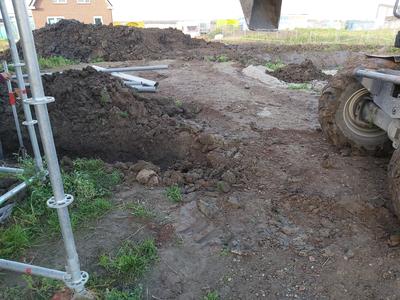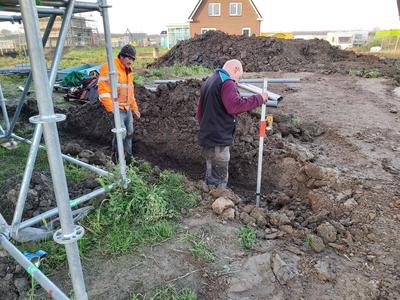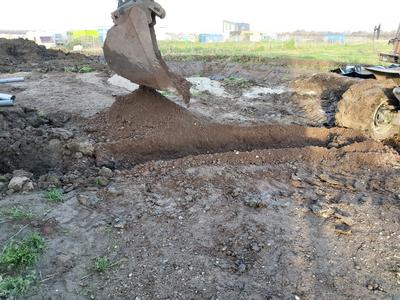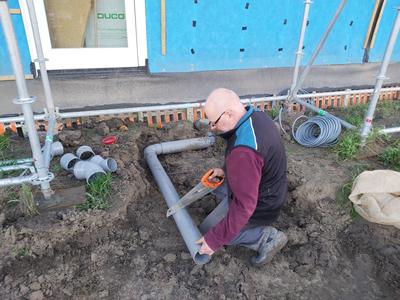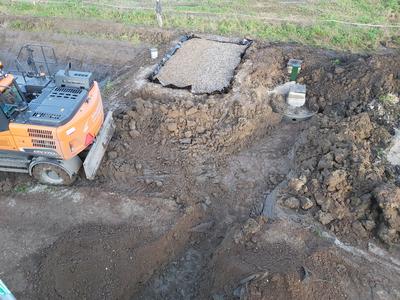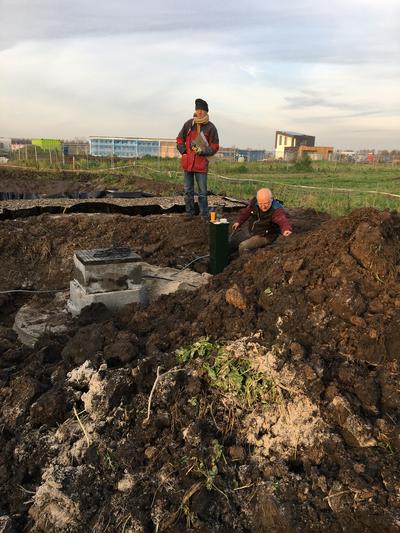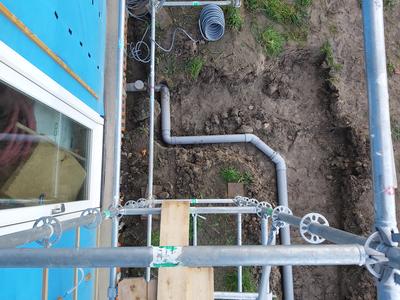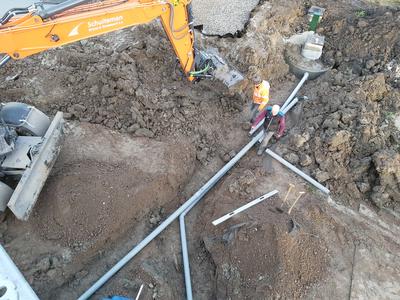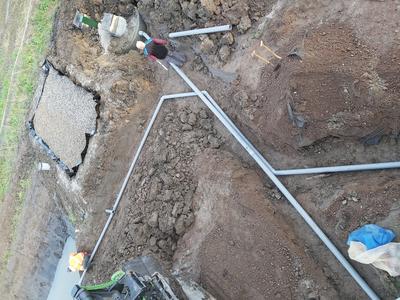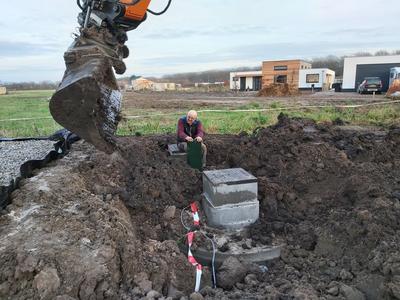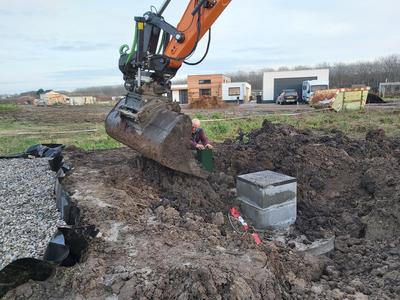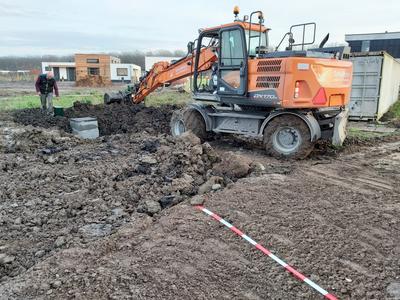| Working on the exterior this week |
Tried to get Internet |
Wastewater and Rainwater
This week our rainwater and wastewater systems were installed!
Monday 14 December
After a full day working from home, we went to the new house. I actually had a lot of work to do at the new house. Cut the planks, sand them and give the ends a first layer of paint.
 While we worked on this, the Dutch prime minister held a speech about the situation in the Netherlands. He addressed the pandemic and what will be done about it going forward. There will be a lockdown for the next five weeks.
While we worked on this, the Dutch prime minister held a speech about the situation in the Netherlands. He addressed the pandemic and what will be done about it going forward. There will be a lockdown for the next five weeks.
He held the speech from his residence, the Cats House in the Hague. “From the tower.” Apparently, this was something special. It indicated that this was a severe speech. It is not a television studio, that is for sure. Sounds from outside the street came in and were clearly to be heard throughout the speech. You could hear people protesting outside. I had hoped that this would be a serious, angry, and emotional speech, but that was not the case. I think Mark was sitting a little stiff behind his desk.
 I hoped that Mark Rutte would deliver a speech like the Prime Minister of Manitoba in Canada, Brian Pallister, on 3 December “If you don’t think COVID-19 is real, right now, you are an idiot”. That is the way to talk. He is showing emotions. He uses his hands, and he is saying the things people need to hear. Brians’ speech impresses me more even though his jacket looks too big.
I hoped that Mark Rutte would deliver a speech like the Prime Minister of Manitoba in Canada, Brian Pallister, on 3 December “If you don’t think COVID-19 is real, right now, you are an idiot”. That is the way to talk. He is showing emotions. He uses his hands, and he is saying the things people need to hear. Brians’ speech impresses me more even though his jacket looks too big.
Tuesday 15 December
Today we worked from home the entire day. In the evening, I went to the new house and painted a second and final layer on the planks. It means we could theoretically put them up tomorrow, Wednesday, but I have no idea how things will pan out tomorrow. We will see.
I told my wife that for me, it feels like tomorrow is a more important day than when the house was delivered. That is strange, though, because that was a pretty big event. It can be that when the house was delivered, it was not really our event. It was in the hands of the builder. We were, in a way, spectators to the event. We were on the first row, obviously, but emotionally, we had no role in what would happen. Just as a side note, we even went back to our old home to work when our house was delivered, and this time we had a day off. The company delivering the wastewater system is orchestrating what will happen, but we are more integrated into the process.
Our neighbor had parked his car on our driveway. That was no problem, but we still had one todo to fix early in the morning. We had to put down the ladder of the scaffold. It is a metal ladder fastened at the top of the scaffold, and it was standing right in the pathway of the sewer pipe. We usually put down the ladder by letting it fall down, but now we had our neighbors car directly under the place where we would like to let the ladder fall. Our neighbor promised to take away the car tomorrow morning.
Wednesday 16 December
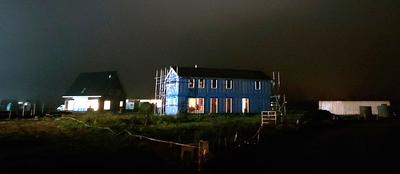 We woke up early. In fact, we woke up so early that I was still driving on the motorway/highway to the new house when my regular alarm clock went off. I had forgotten to turn it off. It is clearly a mistake for an alarm clock software to go off when traveling at 100 kilometers per hour. Could the programmers not be so creative as to make the alarm sound just briefly when the phone is clearly not of a person sleeping? A smartphone with dumb software.
We woke up early. In fact, we woke up so early that I was still driving on the motorway/highway to the new house when my regular alarm clock went off. I had forgotten to turn it off. It is clearly a mistake for an alarm clock software to go off when traveling at 100 kilometers per hour. Could the programmers not be so creative as to make the alarm sound just briefly when the phone is clearly not of a person sleeping? A smartphone with dumb software.
It was a misty morning, and when we arrived, it was still dark. We parked the car elsewhere so that it would not be in the way when the equipment arrived. Dark is not the correct word because it was so well lit due to neighbors’ building light that we could easily see where we put our feet.
Indeed, our neighbor had removed his car. That was nice. We could let the ladder tip over and fall down on the circle of the driveway. With the ladder down, it was not that easy to work on the scaffold. That was for a later worry. We placed the ladder in front of the house.
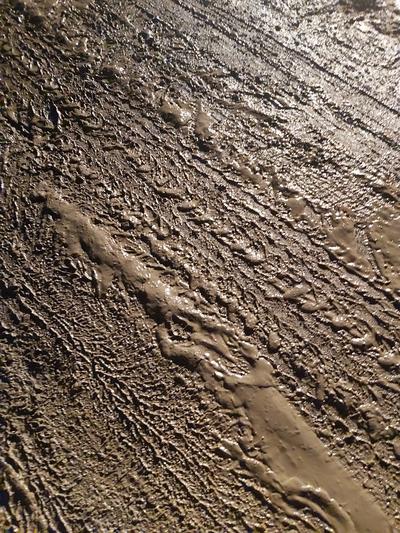
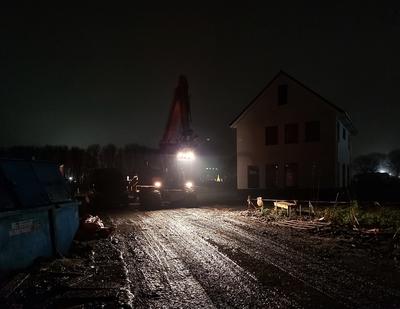 The digger Gert arrived while it was still dark. He had to find a place to put his things. That took a moment. The water systems specialist had not arrived yet. For a brief moment, the lights of the digger machine cast its lights over the dirt road. It is a dirt road that lives up to the name. This is a sticky form of clay you can only find in this area. The land here is reclaimed seafloor. You can see the tracks of vehicles using the road. In a way, it is a form of abstract art.
The digger Gert arrived while it was still dark. He had to find a place to put his things. That took a moment. The water systems specialist had not arrived yet. For a brief moment, the lights of the digger machine cast its lights over the dirt road. It is a dirt road that lives up to the name. This is a sticky form of clay you can only find in this area. The land here is reclaimed seafloor. You can see the tracks of vehicles using the road. In a way, it is a form of abstract art.
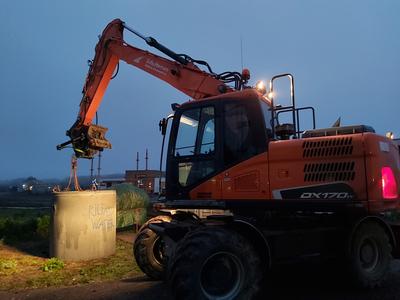
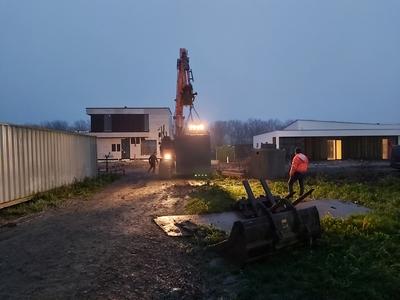 The first task of the day for the digger was to move in the tanks nearer to the final destination. Gerrit examined the marks I had made for the water reservoir and the filter. It was not entirely correct. There had to be more room between the filter and the reservoir. That was easy to fix. We moved the marks and recalculated that the shape was still of the correct size.
The first task of the day for the digger was to move in the tanks nearer to the final destination. Gerrit examined the marks I had made for the water reservoir and the filter. It was not entirely correct. There had to be more room between the filter and the reservoir. That was easy to fix. We moved the marks and recalculated that the shape was still of the correct size.
Where would we place the clay coming out of the reservoir? I already had it figured out that it would be a “huge” amount of clay. This was not something my wife had been thinking about. The more elaborate tasks given to the digging machine, the longer the work would take and the more it would cost. My idea was that we should ask Gert in the digger to finish this corner of the plot to put the excess clay in a place we could reach it without the need to disturb the helophyte system. We will have a machine to work on the landscaping, but it needs to avoid this area. It will be a nogo area for other machines. Gert placed the excess clay at the end of the driveway at the circle. We can use that clay from that place without driving in at the filter and the tanks. There came a little heap on the other side, but that is fine as well. Gerrit was delighted we had the room to maneuver big machines on the plot and space to build the system. This has been part of our plan from the beginning to have enough space around us. It is a luxury not only for us but also for people coming and working for us.
With all this elaboration about where things will go, the work started for real. Here below is a slide show of the work in the morning. At the bottom, there is a pause button that you can click on to pause the automatic slide and turn on step mode. In step mode, it is possible to go left and right in the slide show.
|
As the Dutch say it “Hup” let’s work! 30 seconds later, there is a hole in the ground. How is that possible? |
|
|
Gerrit had a helper, his name was Irving. They spoke English with each other. |
|
|
You can clearly see the text “Kilian Water” on the tank. It is being lowered into the hole. |
|
|
Then there is a second tank placed next to the first. |
|
|
The two tanks are connected to each other with the help of a pipe. |
|
|
“Up” |
|
|
A little more finicking to get it right. These three people were good team players. Gerrit, Gert, and Irving. A few moments later, it was done. |
|
|
In a couple of spare moments, this irrigation system was assembled to be ready for being applied in the filter. |
|
|
Here is the filter dugout. It is 3.2 by 5 meters. Irving is holding a receiver that picks up the signal from a laser to precisely measure the level. |
At this point, we decided to have a break. It was the only break for the entire day. The rest of the day, people were eating while working. Gert in the digger had a sandwich ready to eat while Gerrit was busy with other things. Clearly, these people came for work, not for the coffee breaks.
|
It was time for placing the inspection pit. This is the place that the water municipality will measure how well we behave. Can you see the first faint rays of sunlight in this photo? |
|
|
At the bottom of the filter, they applied heavy-duty foil. This formed a sort of basin. |
|
|
All the exciting stuff that Gerrit had brought with him was unloaded. |
|
|
It was fantastic weather this day! |
|
|
The edge of the basin was decorated with the ingredients. |
|
|
A truck driver was now supposed to show up with more ingredients for the filter. |
|
|
And there he was. The truck was 50 metric tonnes of weight. It is the heaviest load our driveway has carried ever. Gert in the digger machine was not impressed by our driveway. |
|
|
We paid an overprice for the driveway. I am aware of that. On the other hand, it held up today! |
|
|
At this point, I was disturbed. Will this truck come back up on the driveway? |
|
|
The truck driver was also part of this team! Obviously, they knew each other really well. |
Here was the filter assembled. There go different ingredients in different layers in the basin. Kilian Water is ranked as the best supplier of helophyte filters in the Netherlands, and I asked him why this is not screamed out loud from the rooftops. The answer was that he would get too much work, which could lower his systems’ quality. Besides, according to Gerrit, some of the quality results from a mutual relationship between the customer and the provider. The other parts are in the small details, small secret details. If he increases the customer numbers, then some of that relationship would get lost. He appreciates customers who embrace the commitment, pays their invoices on time, and appropriately use their filter correctly. Gerrit heard other providers of filters that sometimes (but not always) prioritize quantity over quality. Gerrit liked his job as it is right now and needs not to grow his company rapidly.
It is actually straightforward. Anyone with a bit of land can buy a helophyte filter provided they got the permits from the water municipality. But just by buying a helophyte filter does not mean you automatically care about the environment or the future of the Netherlands’ nature. It is possible to buy a filter and supposedly shuffle off all responsibility of working the filter to the selling company. Here is the trick, some providers sell the filter like you don’t need to take any responsibility. They call it “unburdening.” It will cost you money, but they tell you that you have almost no responsibility. What could possibly go wrong with that? Whenever I hear about schemes making it possible to delegate responsibility to someone or something else, it upsets my sense of morality. If it is done for five hundred euros per year for the next 30 years, it upsets my common sense.
It is charming to see how people are working together in the Netherlands. As soon as you got away from the low-budget craftsmen in the Netherlands, you see that they work in loosely coupled rings. For example, our electrician and the woodstove specialist know each other. The electrician knows the plumber and so on. When you invite them to work on a project like this, you treat them well and pay your invoices on time; you get access to their expertise. If you need something done, they often know someone who can do it.
Here in the wastewater filter world, I could see similar things. The man driving the digger works a lot together with Gerrit. Now also the truck driver arrived and helped out preparing the filter. The others asked the truck driver how it was going with his daughter having health issues, and he was encouraged to keep up the mood. It looked like he appreciated the words from the others. Gerrit needs a good relationship with the company delivering the material. The sand and all the other ingredients need to be precisely correct.
|
The truck came back up on the driveway. The driver took a little sand that he sprinkled over the metal sheets to get a proper grip. |
|
|
There was a tiny little heap of sand left. I took a bucket of this that I put away. I had no hopes anything would be left lying here at the end of the day. |
|
|
Here the team shifted tasks. The idea was to dig the reservoir and then finish the rest of the system. |
|
|
I had designed the reservoir in CAD according to specifications by the water municipality. When talking to the Gert driving the digger, we found ways of fulfilling the municipality’s requirements while making the design more straightforward. That saved hours upon hours of digging. |
|
|
In my design, there was a plateau at one meter—no need for that. Gerrit helped to measure the slope angle with the laser. That angle had to be mostly correct. |
|
|
When the reservoir was finished, Gerrit went buying more pipes while Irving, Gert, and I finished the filter. Here are the plants protected with buckets while gravel is poured over. |
|
|
Irving cut a hole at the bottom of the bag, and Gert distributed the bags’ content over the filter. |
|
|
Next up, it was time to connect the sewer to the house and the rainwater to the reservoir. Both had to go straight over the driveway. |
|
|
The laser was handy for measuring the slope. |
|
|
Gert put the gravel of the driveway separately. |
|
|
Here was the sewer pipe leaving the house. |
|
|
Gert dug a trench across the driveway to the tanks. |
|
|
Here I am standing contemplating what Gerrit just said. |
|
|
Gert also dug a trench from the rainwater system crossing the sewer pipe going to the reservoir. |
|
|
The sewer pipe in place. |
|
|
The sewer pipe goes straight to the first tank. Behind the tank is a little green cupboard for the electricity of the pump in the second tank. |
|
|
The pipes in place. The slope was measured with the laser. Here at this moment, I took the opportunity to measure the lengths of the different pieces. That way, I can draw this in CAD later. |
|
|
Here Gerrit is holding the green cupboard while Gert is gently filling up around it. They almost have the same name, how is it possible? |
|
|
These two men need to have absolute trust in each other to work like this. Gerrit said: When I am working with Gert, I dare to do more because he will save me with his digging machine. |
|
|
This was the last photo I took today. |
The sun was still up when the filter was finished. Gerrit was proud of the work done today, and I was also proud to be part of this. It was feeling special to be part of this. I think I will remember this day for a long time as a pleasant project.
There was no time to work on the planks today. It turned out that we were so tired that we took a break from the new house on Thursday and Friday evenings.
 Saturday 19 December
Saturday 19 December
Our car had dropped dirt at the parking this morning! I will need to wash the car because it will soon go through its annual vehicle safety test.
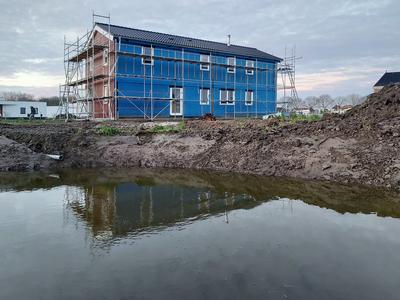 This morning, we tried to arrive early at the new house, but it did not really work out. We were early enough, though. The first thing we did when we arrived was to inspect the new reservoir and the filter. It looked perfect. There was water in our pond.
This morning, we tried to arrive early at the new house, but it did not really work out. We were early enough, though. The first thing we did when we arrived was to inspect the new reservoir and the filter. It looked perfect. There was water in our pond.
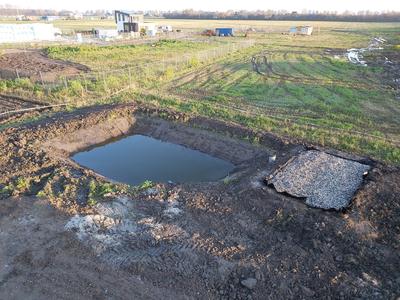 I do like the look of the water in the reservoir. We will have plants growing along the edge, and I think we might want to have some path to the water. Right now, the slope is relatively hard and slippery because of the digger. We will see how this develops. It is not entirely a priority right now.
I do like the look of the water in the reservoir. We will have plants growing along the edge, and I think we might want to have some path to the water. Right now, the slope is relatively hard and slippery because of the digger. We will see how this develops. It is not entirely a priority right now.
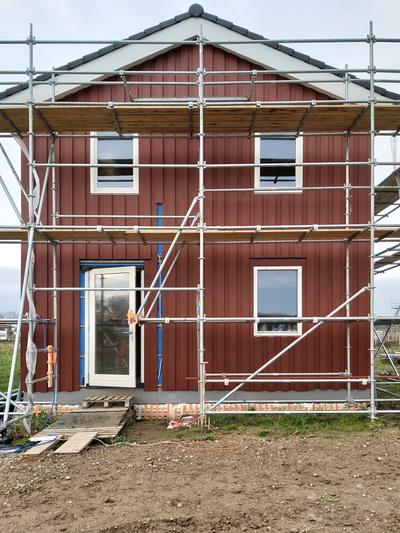 Today we had decided to mount the last planks of the east wall. It turned out to be so that we had one plank that was incorrect on the door’s left side. We also forgot a horizontal plank above the door. All the rest went fine. Next to the door on the right side, we decided to install an electrical outlet and a doorbell. For that purpose, we removed that entire plank to get access to the wires. Although we got a few smaller tasks to finish on the east wall, we decided to move on.
Today we had decided to mount the last planks of the east wall. It turned out to be so that we had one plank that was incorrect on the door’s left side. We also forgot a horizontal plank above the door. All the rest went fine. Next to the door on the right side, we decided to install an electrical outlet and a doorbell. For that purpose, we removed that entire plank to get access to the wires. Although we got a few smaller tasks to finish on the east wall, we decided to move on.
But first, we connected two of the rain gutter drains via a temporary downpipe to the water pipe going to the reservoir. The first time we mounted the temporary downpipe was on 21 October. That did not work at all. That time we had the pipes hanging loos. The pipes were fluttering in the wind as naïve art installations until they broke. This time we mounted them at the top and at the bottom connecting the gutters to the system of pipes ending at the water reservoir. There are two more downpipes, but this was it for today.
We moved the ladder back to the north side of the scaffold as well. Personally, I cannot stand it when things have not been appropriately finished, so we will need to go back to the few planks of the east wall and do them as well. So what is precisely missing on the east wall:
- Remake the plank on the left side of the door.
- Plank above the door.
- Wallmount for the electrical outlet.
- Mount for the doorbell.
- The light above the door.
- Window sills, above and under the window. One sill on top of the door.
- Paint the kit of the fascia boards.
- Cut the bottom planks to a straight line and paint the ends.
- Remove the scaffold on the west side.
- Apply gravel to the driveway so that it meets up with the building.
For the window sills and the kit, it is necessary to keep the scaffold as it is. For the gravel, the scaffold needs to be removed.
As a last task of the day, we reshuffled a couple of wood stacks inside the container to get access to ventilated beams so that we can begin on the north wall tomorrow.
Sunday 20 December
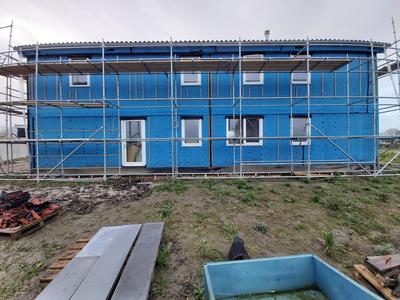 Sunday morning feels nice because there is plenty of time left to finish things. We arrived at the new house and started by lighting a fire in the woodstove. That was a bad idea because we were about to work directly below the chimney. Lesson learned that when we are busy on the north side, it is better not to light a stove fire.
Sunday morning feels nice because there is plenty of time left to finish things. We arrived at the new house and started by lighting a fire in the woodstove. That was a bad idea because we were about to work directly below the chimney. Lesson learned that when we are busy on the north side, it is better not to light a stove fire.
The scaffold had railings on the outer side but not on the inner side. The first task was to put these up. It feels much more comfortable to have a railing to lean against when working with the planks. It is not so that we have many spare parts of the scaffold lying, so we had to remove parts here and there not absolutely necessary and used those.
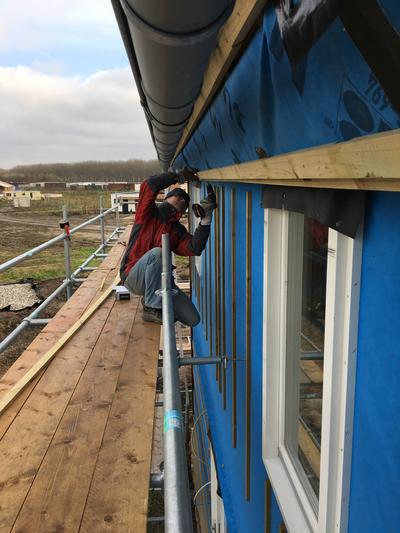
The first real task was to put up ventilated beams to be under the fascia boards. We had planned to put up fascia boards along the entire north side, so we needed ventilated beams along the entire side. First had a bucket with screws that I dragged with me and picked out screws one at a time, and applied them on the beam at the final place. We figured that if I put the screws a little bit in the beam evenly spread and then placed the beam at the final place, it was much quicker because there was no fiddling with the screens. This went enormously nice until it turned out that the space was cramped at some places, and the angle of the screws put in on beforehand made it impossible to get it in with the electric screwdriver. There was no space for it. With that lesson, we figured out that the screws put in on beforehand had to be angled so that there will be room for the screwdriver as well on the final position. At that point, we were on the last beam. I really do wonder if I will remember this conclusion until the next time. We finished the beams today. That was nice.
It was not the time for starting to create the fascia boards when we had finished the beams. That is a task we start another time. Instead, we cut the plank on the door’s left side and the plank above the door.
A neighbor was busy cleaning up their yard. He was just about to throw away wood beams. I went to him and asked if I could have them. That was okay. His wife arrived and asked what I was going to do with all that junk. I showed her different planks and what I could do with them, and then I said that “those thin beams I can use instead of buying new bamboo sticks.” Then she collected all of them and walked away with them while she said, “ooh, that is a good idea.” Haha, I am always so open about everything.
It was an intense week, Especially Wednesday. We are delighted with the result. It will be marvelous when we get the toilet installed. Will it happen next week? I am not sure. We made no clear agreements with how the work continues during the holidays. Our electrician is not having any days off, that is for sure. It feels good that most planks on the east wall are up.
One little note on the blog of last week: Spiders don’t hold their ears. I am well aware of that. It was a joke.
With that ends this week’s blog. It was a lovely week!
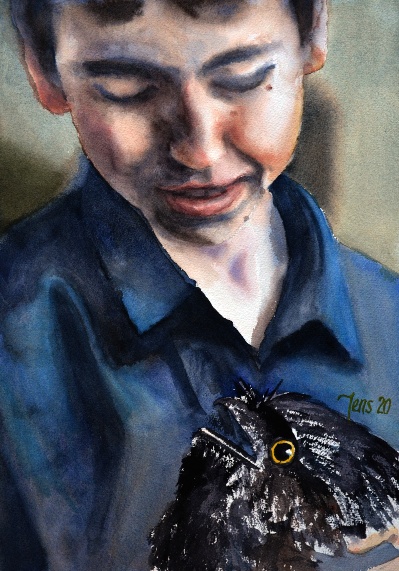
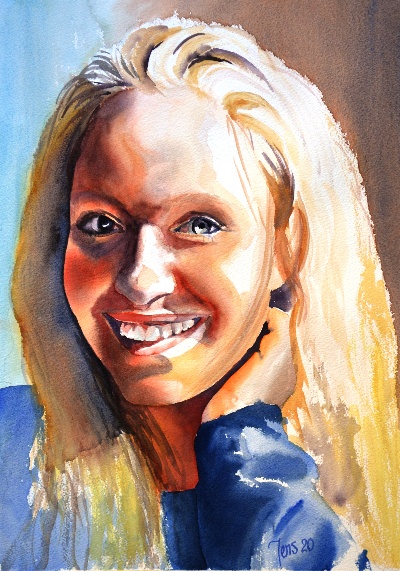
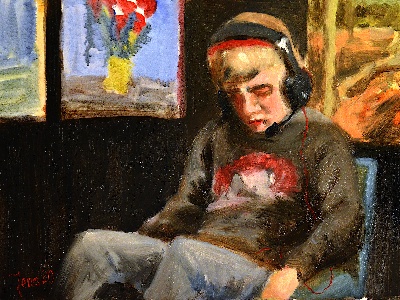
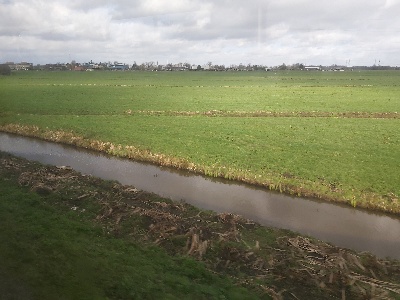
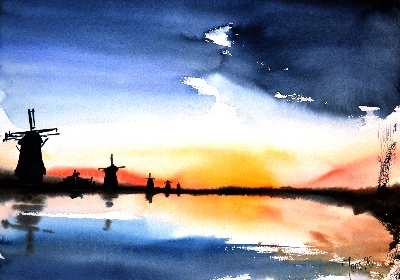
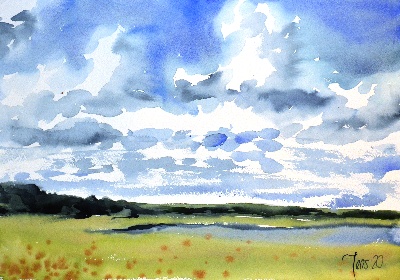

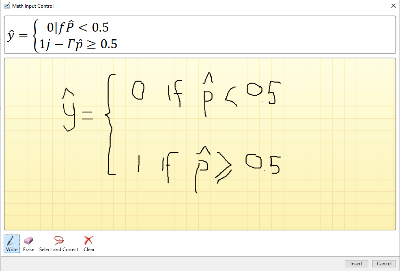
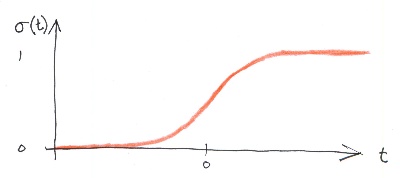
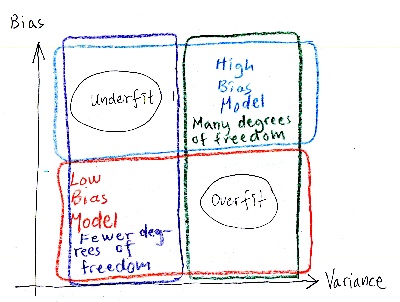
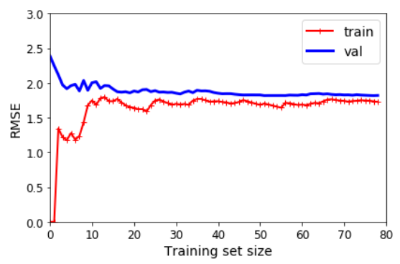
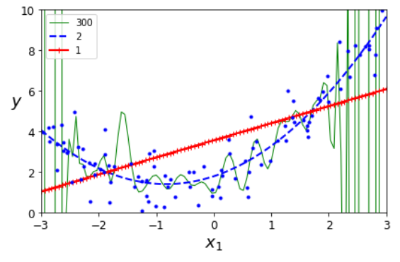


 Installed the Murphy bedMore gypsum boards in the barnThe lamps in the hallway were installedInstalled more lamp fixturesLight installationsSea container picked upSea container soldFinished cleaning the sea containerNice sunrise picturesGreat progress in the barnSeacontainer on saleSea container is empty!Sea container almost empty!Moving planksThis week no activities in the barn
Installed the Murphy bedMore gypsum boards in the barnThe lamps in the hallway were installedInstalled more lamp fixturesLight installationsSea container picked upSea container soldFinished cleaning the sea containerNice sunrise picturesGreat progress in the barnSeacontainer on saleSea container is empty!Sea container almost empty!Moving planksThis week no activities in the barn I moved from Sweden to The Netherlands in 1995.
I moved from Sweden to The Netherlands in 1995.
Here on this site, you find my creations because that is what I do. I create.
